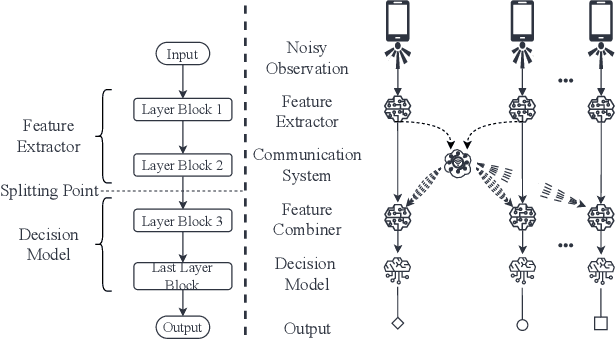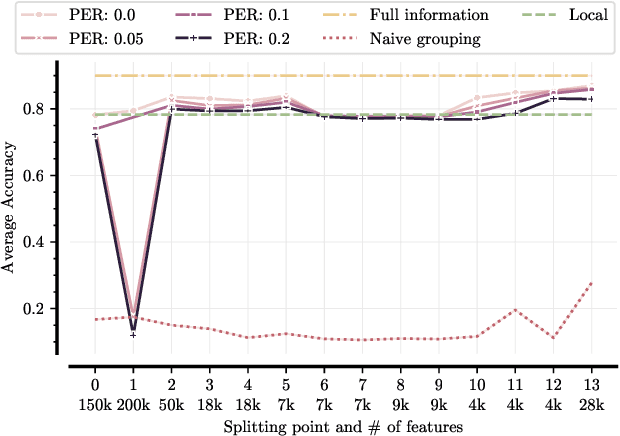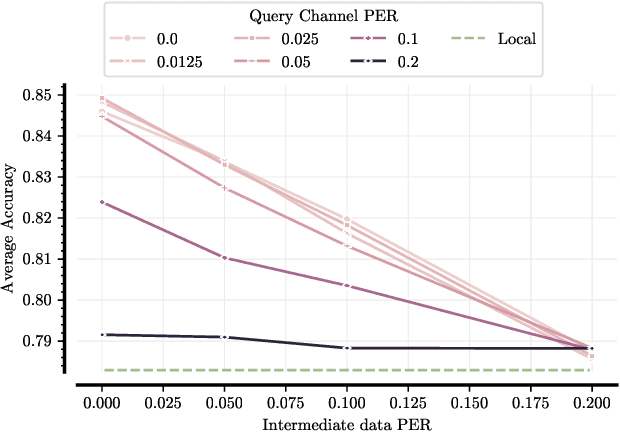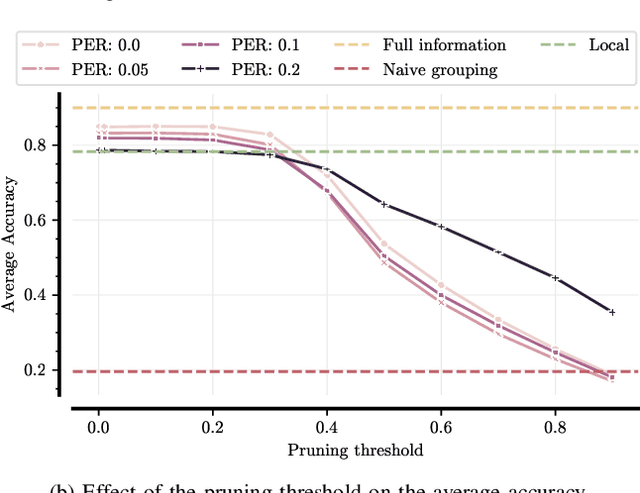Mattia Merluzzi
Joint Channel and Semantic-aware Grouping for Effective Collaborative Edge Inference
Oct 02, 2025Abstract:We focus on collaborative edge inference over wireless, which enables multiple devices to cooperate to improve inference performance in the presence of corrupted data. Exploiting a key-query mechanism for selective information exchange (or, group formation for collaboration), we recall the effect of wireless channel impairments in feature communication. We argue and show that a disjoint approach, which only considers either the semantic relevance or channel state between devices, performs poorly, especially in harsh propagation conditions. Based on these findings, we propose a joint approach that takes into account semantic information relevance and channel states when grouping devices for collaboration, by making the general attention weights dependent of the channel information. Numerical simulations show the superiority of the joint approach against local inference on corrupted data, as well as compared to collaborative inference with disjoint decisions that either consider application or physical layer parameters when forming groups.
Collaborative Edge Inference via Semantic Grouping under Wireless Channel Constraints
Oct 02, 2025



Abstract:In this paper, we study the framework of collaborative inference, or edge ensembles. This framework enables multiple edge devices to improve classification accuracy by exchanging intermediate features rather than raw observations. However, efficient communication strategies are essential to balance accuracy and bandwidth limitations. Building upon a key-query mechanism for selective information exchange, this work extends collaborative inference by studying the impact of channel noise in feature communication, the choice of intermediate collaboration points, and the communication-accuracy trade-off across tasks. By analyzing how different collaboration points affect performance and exploring communication pruning, we show that it is possible to optimize accuracy while minimizing resource usage. We show that the intermediate collaboration approach is robust to channel errors and that the query transmission needs a higher degree of reliability than the data transmission itself.
Adaptive Semantic Token Communication for Transformer-based Edge Inference
May 23, 2025Abstract:This paper presents an adaptive framework for edge inference based on a dynamically configurable transformer-powered deep joint source channel coding (DJSCC) architecture. Motivated by a practical scenario where a resource constrained edge device engages in goal oriented semantic communication, such as selectively transmitting essential features for object detection to an edge server, our approach enables efficient task aware data transmission under varying bandwidth and channel conditions. To achieve this, input data is tokenized into compact high level semantic representations, refined by a transformer, and transmitted over noisy wireless channels. As part of the DJSCC pipeline, we employ a semantic token selection mechanism that adaptively compresses informative features into a user specified number of tokens per sample. These tokens are then further compressed through the JSCC module, enabling a flexible token communication strategy that adjusts both the number of transmitted tokens and their embedding dimensions. We incorporate a resource allocation algorithm based on Lyapunov stochastic optimization to enhance robustness under dynamic network conditions, effectively balancing compression efficiency and task performance. Experimental results demonstrate that our system consistently outperforms existing baselines, highlighting its potential as a strong foundation for AI native semantic communication in edge intelligence applications.
Goal-oriented Spectrum Sharing: Trading Edge Inference Power for Data Streaming Performance
Mar 14, 2025



Abstract:We study the problem of spectrum sharing between goal-oriented (GO) and legacy data-oriented (DO) systems. For the former, data quality and representation is no longer optimized based on classical communication key performance indicators, but rather configured on the fly to achieve the goal of communication with the least resource overhead. This paradigm can be followed to flexibly adapt wireless and in-network artificial intelligence operations across different nodes (e.g., access points, users, sensors or actuators) to data traffic, channel conditions, energy availability and distributed computing capabilities. In this paper, we argue and demonstrate that computing and learning/inference operation performance strongly affect lower layers, calling for a real cross-layer optimization that encompasses physical and computation resource orchestration, up to the application level. Focusing on a communication channel shared among a GO and a DO user, we define a goal-effective achievable rate region (GEARR), to assess the maximum data rate attainable by the latter, subject to goal achievement guarantees for the former. Finally, we propose a cross-layer dynamic resource orchestration able to reach the boundaries of the GEARR, under different goaleffectiveness and compute resource consumption constraints.
Semantic and Goal-oriented Wireless Network Coverage: The Area of Effectiveness
Feb 25, 2025Abstract:Assessing wireless coverage is a fundamental task for public network operators and private deployments, whose goal is to guarantee quality of service across the network while minimizing material waste and energy consumption. These maps are usually built through ray tracing techniques and/or channel measurements that can be consequently translated into network Key Performance Indicators (KPIs), such as capacity or throughput. However, next generation networks (e.g., 6G) typically involve beyond communication resources, towards services that require data transmission, but also processing (local and remote) to perform complex decision making in real time, with the best balance between performance, energy consumption, material waste, and privacy. In this paper, we introduce the novel concept of areas of effectiveness, which goes beyond the legacy notion of coverage, towards one that takes into account capability of the network of offering edge Artificial Intelligence (AI)-related computation. We will show that radio coverage is a poor indicator of real system performance, depending on the application and the computing capabilities of network and devices. This opens new challenges in network planning, but also resource orchestration during operation to achieve the specific goal of communication.
Goal-oriented Communications based on Recursive Early Exit Neural Networks
Dec 27, 2024Abstract:This paper presents a novel framework for goal-oriented semantic communications leveraging recursive early exit models. The proposed approach is built on two key components. First, we introduce an innovative early exit strategy that dynamically partitions computations, enabling samples to be offloaded to a server based on layer-wise recursive prediction dynamics that detect samples for which the confidence is not increasing fast enough over layers. Second, we develop a Reinforcement Learning-based online optimization framework that jointly determines early exit points, computation splitting, and offloading strategies, while accounting for wireless conditions, inference accuracy, and resource costs. Numerical evaluations in an edge inference scenario demonstrate the method's adaptability and effectiveness in striking an excellent trade-off between performance, latency, and resource efficiency.
Optimizing RIS Impairments through Semantic Communication
Oct 10, 2024



Abstract:This paper investigates how semantic communication can effectively influence and potentially redefine the limitations imposed by physical layer settings. Reconfigurable Intelligent Surfaces (RIS) enable the intelligent configuration of the physical layer of communication systems. However, its practical implementation is hampered by several limitations. The Semantic Communication (SemCom) paradigm introduces additional degrees of freedom that can be exploited to improve the robustness of communication against physical layer impairments. In essence, SemCom ensures that the data representation remains robust even under adverse physical conditions by emphasizing the transmission of meaningful information in a manner that is less susceptible to degradation. Through the use of SemCom, potential RIS gains are demonstrated in terms of RIS area size and the phase shift precision of its active elements.
Goal-Oriented and Semantic Communication in 6G AI-Native Networks: The 6G-GOALS Approach
Feb 12, 2024


Abstract:Recent advances in AI technologies have notably expanded device intelligence, fostering federation and cooperation among distributed AI agents. These advancements impose new requirements on future 6G mobile network architectures. To meet these demands, it is essential to transcend classical boundaries and integrate communication, computation, control, and intelligence. This paper presents the 6G-GOALS approach to goal-oriented and semantic communications for AI-Native 6G Networks. The proposed approach incorporates semantic, pragmatic, and goal-oriented communication into AI-native technologies, aiming to facilitate information exchange between intelligent agents in a more relevant, effective, and timely manner, thereby optimizing bandwidth, latency, energy, and electromagnetic field (EMF) radiation. The focus is on distilling data to its most relevant form and terse representation, aligning with the source's intent or the destination's objectives and context, or serving a specific goal. 6G-GOALS builds on three fundamental pillars: i) AI-enhanced semantic data representation, sensing, compression, and communication, ii) foundational AI reasoning and causal semantic data representation, contextual relevance, and value for goal-oriented effectiveness, and iii) sustainability enabled by more efficient wireless services. Finally, we illustrate two proof-of-concepts implementing semantic, goal-oriented, and pragmatic communication principles in near-future use cases. Our study covers the project's vision, methodologies, and potential impact.
Power Minimizing MEC Offloading with QoS Constraints over RIS-Empowered Communications
Dec 15, 2023Abstract:This work lies at the intersection of two cutting edge technologies envisioned to proliferate in future 6G wireless systems: Multi-access Edge Computing (MEC) and Reconfigurable Intelligent Surfaces (RISs). While the former will bring a powerful information technology environment at the wireless edge, the latter will enhance communication performance, thanks to the possibility of adapting wireless propagation as per end users' convenience, according to specific service requirements. We propose a joint optimization of radio, computing, and wireless environment reconfiguration through an RIS, with the goal of enabling low power computation offloading services with reliability guarantees. Going beyond previous works on this topic, multi-carrier frequency selective RIS elements' responses and wireless channels are considered. This opens new challenges in RIS optimization, accounting for frequency dependent RIS response profiles, which strongly affect RIS-aided wireless links and, as a consequence, MEC service performance. We formulate an optimization problem accounting for short and long-term constraints involving device transmit power allocation across multiple subcarriers and local computing resources, as well as RIS reconfiguration parameters according to a recently developed Lorentzian model. Besides a theoretical optimization framework, numerical results show the effectiveness of the proposed method in enabling low power reliable computation offloading over RIS-aided frequency selective channels.
Enabling Edge Artificial Intelligence via Goal-oriented Deep Neural Network Splitting
Dec 06, 2023



Abstract:Deep Neural Network (DNN) splitting is one of the key enablers of edge Artificial Intelligence (AI), as it allows end users to pre-process data and offload part of the computational burden to nearby Edge Cloud Servers (ECSs). This opens new opportunities and degrees of freedom in balancing energy consumption, delay, accuracy, privacy, and other trustworthiness metrics. In this work, we explore the opportunity of DNN splitting at the edge of 6G wireless networks to enable low energy cooperative inference with target delay and accuracy with a goal-oriented perspective. Going beyond the current literature, we explore new trade-offs that take into account the accuracy degradation as a function of the Splitting Point (SP) selection and wireless channel conditions. Then, we propose an algorithm that dynamically controls SP selection, local computing resources, uplink transmit power and bandwidth allocation, in a goal-oriented fashion, to meet a target goal-effectiveness. To the best of our knowledge, this is the first work proposing adaptive SP selection on the basis of all learning performance (i.e., energy, delay, accuracy), with the aim of guaranteeing the accomplishment of a goal (e.g., minimize the energy consumption under latency and accuracy constraints). Numerical results show the advantages of the proposed SP selection and resource allocation, to enable energy frugal and effective edge AI.
 Add to Chrome
Add to Chrome Add to Firefox
Add to Firefox Add to Edge
Add to Edge